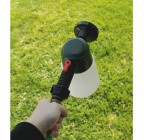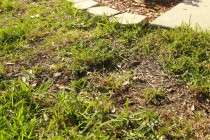If your lawn or garden beds aren’t thriving, you want to get to the root of the problems and cover all the basics – healthy soil, pest control, pruning and irrigation. Here are a few general tips to help you get more growing in your yard.
Test the Soil
Pick up a soil test kit to test the soil pH level. This easy, but usually overlooked step, will reveal what your soil needs. Without knowing if your soil is alkaline or acidic, you could inadvertently apply the wrong combinations of nutrients and amendments, or plant something in the wrong spot.
Cultivate Soil
Heavily compacted soil prevents roots from spreading. Plants prefer well-drained, loamy soil (fertile soil containing humus). Add compost to flower, shrub and vegetable beds and turn over or till the soil to break it up. Don’t cultivate soil when it is wet. That will compact it even more and disturb beneficial microorganisms. Rent an aerator to loosen soil on a compacted lawn.
Fertilize Properly
Never use a single type of fertilizer universally. Lawns, shrubs, trees, flowers and vegetables each have specific nutrient requirements. Soil conditions (based on testing) also dictate specific needs. Also, fertilizing at the wrong time, too little or too frequently, will have a negative result.
Control Pests and Diseases
Using pesticides improperly can be harmful to plants, pets and humans. Controls are formulated for specific purposes and should be used only as recommended on the product’s label. As a first step, determine what pests or diseases your plants have by bringing samples to your extension service or the garden center manager at your local Ace.
Irrigate
Plants are like people when it comes to water. Too little and they dehydrate; too much and they drown. As a general rule, most plants prefer water at their “feet,” not on their “heads.” So, water at soil level, not by overhead spraying an entire bed. It is important to know when to water. You can use a moisture meter, by pushing the prong into the soil to various depths around a plant.
Mulch
Covering a soil bed with mulch will retain moisture and keep plant roots cooler. And organic mulch helps maintain better soil conditioning. 3 to 6 inches covering the soil will help protect plants from drought and help cut down on watering. Just make sure you don’t pile it up against tree trunks or plant stems. This can lead to rotting.
Prune Selectively
Some plants prefer pruning in early spring, while others can be trimmed during summer or fall. Generally, anything that flowers in the spring should be pruned after flowers die off. There are exceptions, however, so do a little research to prune correctly for the shrubs and trees in your yard.
Check Soil Temperatures Before Planting
Interestingly, horticulturists have found that how well plants adapt to transplanting or seeding depends upon the temperature of the soil at the time of planting. In some cases, plantings before the last frost do well; in other cases the soil must be at a consistent temperature (say 55ºF) for a period of time to achieve maximum results.
For more helpful tips, visit Ace Hardware’s Tips & Advice
Published: 3/5/2020


